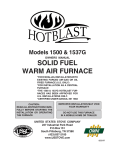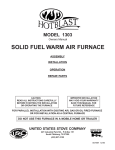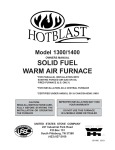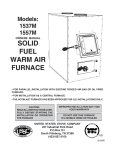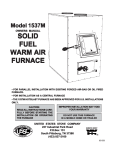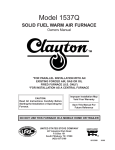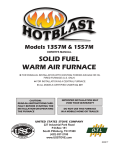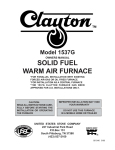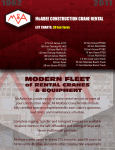Download United States Stove 1200Q Operating instructions
Transcript
Model 1200Q SOLID FUEL WARM AIR FURNACE Owners Manual HOTBLAS T *FOR PARALLEL INSTALLATION WITH AN EXISTING FORCED AIR, GAS OR OIL FIRED FURNACE (U.S. ONLY) *FOR INSTALLATION AS A CENTRAL FURNACE CAUTION: Read All Instructions Carefully Before Starting the Installation or Operating the Furnace. Improper Installation May Void Your Warranty Save This Manual For Future Reference STATES STO TED V NI UNITED STATES STOVE COMPANY COMPANY 227 Industrial Park Road P.O.Box 151 South Pittsburg, TN 37380 (423) 837-2100 USSC E U DO NOT USE THIS FURNACE IN A MOBILE HOME OR TRAILER •DRAWINGS FOR ILLUSTRATION PURPOSES ONLY• WARNOCK HERSEY R 851282A 4/99 1 CONGRATULATIONS! You've purchased one of America's Finest Wood Burning Furnaces. By heating with wood you're helping to CONSERVE AMERICA'S ENERGY! Wood is our Renewable Energy Resource. Please do your part to preserve our wood supply. Plant at least one tree each year. Future generations will thank you. NOTE: YOUR UNIT MUST BE INSTALLED BY A QUALIFIED FURNACE INSTALLER. IMPROPER INSTALLATION COULD VOID YOUR WARRANTY! NOTE: (See Page 5, First Paragraph) TOOLS AND MATERIALS NEEDED TOOLS MATERIALS Pencil 6 Foot Folding Rule or Tape Tin Snips Drill, Hand or Electric Drill Bit (For Sheet Metal Screws) 1/8" Dia. Screw Driver (Blade-Type) Gloves Sabre Saw 5/16" Nut Driver or 5/16" Socket with Rachet 2 6" Pipe, 6" Elbow, Collar and Thimble; as required (24 gauge min.) 1/2" Sheet Metal Screws 6" Inside Diameter Listed Residential Type or Building Heating Appliance Chimney or Existing Masonry Chimney (SEE Page 8). Electrical Wiring 6" Draft Regulator 1/2" Conduit (Conduit Connectors) Furnace Cement (Manufacturer Recommends: Rutland Black - Code 78 or Equivalent Plenum and Duct Work as Required •DRAWINGS FOR ILLUSTRATION PURPOSES ONLY• CAUTION: Your Furnace has the following labels. Read and obey all labels. DANGER: RISK OF FIRE OR EXPLOSION. DO NOT burn garbage, gasoline, drain oil, or other flammable liquids. WARNING: FIRE HAZARD. DO NOT operate with fire draft exceeding .06 inches W.C. DO NOT operate with fuel loading or ash removal doors open. DO NOT store fuel or other combustible material within the marked installation clearances. DO NOT store fuels, paints, thinners, flammable liquids, or other highly volatile substances in the furnace room. CAUTION: HOT SURFACES Keep children away. Do not touch during operation. WARM-AIR SUPPLY-DUCT SYSTEM MUST BE CONSTRUCTED ONLY OF METAL CAUTION! INSPECT FLUE PIPES, FLUE PIPE JOINTS AND FLUE PIPE SEALS REGULARLY TO ENSURE THAT SMOKE AND FLUE GASES ARE NOT DRAWN INTO, AND CIRCULATED BY, THE AIR CIRCULATION SYSTEM. CAUTION! CLEANOUT OF THE HEAT EXCHANGER, FLUE PIPE, CHIMNEY, AND DRAFT INDUCER IF USED, IS ESPECIALLY IMPORTANT AT THE END OF THE HEATING SEASON TO MINIMIZE CORROSION DURING THE SUMMER MONTHS, CAUSED BY ACCUMULATED ASH. SAFETY NOTICE: If this heater is not properly installed, a house fire may result. For your safety, follow the installation directions. Contact local building or fire officials about restrictions and installation inspection requirements in your area. REFER TO MARKINGS ON THE APPLIANCE FOR ADDITIONAL INFORMATION. •DRAWINGS FOR ILLUSTRATION PURPOSES ONLY• 3 RULES FOR SAFE INSTALLATION AND OPERATION Read these rules and the instructions carefully. Failure to follow them will cause a hazard that could result in death, serious bodily injury, and/or property damage. Check your local codes. This installation must comply with their rulings. 1. 2. Do not install this furnace in a mobile home or trailer. 3. Always connect this furnace to a chimney and vent to the outside. Never vent to another room or inside a building. 4. Do not connect this furnace to an aluminum Type B gas vent. This is not safe and is prohibited by the National Fire Protection Association Code. This furnace requires a masonry or listed factory built chimney for residential type or building heating appliance chimney. Use a 6" diameter chimney or larger, that is high enough to give a good draft. (See Page 8) 5. Be sure that if a masonry chimney is used, it is safely constructed and in good repair. Have the chimney inspected by the Fire Department or an inspector. 6. Inspect chimney connector and chimney before and frequently during the heating season for any deposit of creosote or soot which must be removed (see Chimney Maintenance, page 21.) 7. Provide air for combustion into the room where the furnace is located. If the intake is not in the same room, air must have free access to the room. 8. CAST IRON PARTS MUST BE "SEASONED" TO AVOID CRACKING. BUILD ONLY SMALL FIRES ON FIRST USE. 9. To prevent injury, do not allow anyone to use this furnace who is unfamiliar with the correct operation of the furnace. 10. For further information on using your furnace safely, obtain a copy of the National Fire Protection Association (NFPA) publication "Chimney's, Fireplaces and Solid Fuel Burning Appliances" NFPA 211. The address of the NFPA is Batterymarch Park, Quincy, MA 02269. 11. Keep the ashpit section free of excess ashes. Do not allow ashes to stack higher than the sides of the ash pan. 12. DISPOSAL OF ASHES - Place ashes in a metal container with a tight fitting lid. Keep the closed container on a noncombustible floor or on the ground, well away from all combustible materials. Keep the ashes in the closed container until all cinders have thoroughly cooled. The ashes may be buried in the ground or picked up be a refuse collector. 13. CAUTION - The special paints used on your furnace may give off some smoke while they are curing during first few fires. Build small fires at first. The metal used in construction of the furnace and duct work has a light coating of oil. This could give off smoke and/or odors from registers when furnace is used for the first time. This should disappear after a short period of time. Once this burn-off has occurred, it should not reoccur. 4 •DRAWINGS FOR ILLUSTRATION PURPOSES ONLY• RULES FOR SAFE INSTALLATION AND OPERATION 14. CARING FOR PAINTED PARTS - This furnace has a painted outside jacket, which is durable but it will not stand rough handling or abuse. When installing you furnace, use care in handling. Clean with soap and warm water when furnace is not hot. DO NOT use any acids or scouring soap, as these wear and dull the finish. DISCOLORATION WILL OCCUR IF THE FURNACE IS OVERFIRED. FOLLOW OPERATING INSTRUCTIONS CAREFULLY. 15. Keep the feed and ash doors closed at all times except while tending the furnace. Your Furnace is designed to be installed in a parallel air flow arrangement with a gas or oil-fired forced air upflow-type central furnace, or it may be installed as a central furnace. HOW THE FURNACE FUNCTIONS Your Supplemental Furnace is designed to be a supplemental or central heating source for your home. This solid fuel furnace may be installed in conjunction with a properly operating central furnace that is listed or certified in accordance with nationally recognized safety standards and equipped with the required controls and other safety features and which has been installed with appropriate standards of National Fire Protection Association with installation clearances specified in the furnace nameplate marking. The installation must be accomplished by a qualified agency (one who is engaged in, and is responsible for, or is thoroughly familiar with the installation and operation of the gas, oil, and solid fuel burning heating appliances, who is experienced in such work, familiar with all precautions required, and has complied with all the requirements of the authority having jurisdiction.) The installation shall be in strict accordance with the manufacturer's installation instructions furnished with the solid fuel furnace. The chimney connector of the furnace is to be installed to provide clearances to combustible material not less than specified in the individual classifications and marked on the furnace. The chimney connector must be connected to a chimney suitable for use with residential type or building heating appliances which burn solid fuel. The furnace is designed to operate in either parallel or series air flow arrangement with the central furnace or as a central furnace. PARALLEL INSTALLATION: The design is such that when the blower comes on, the blower on the central system also comes on. The blower will only come on when the temperature in the plenum has reached the setting on the blower control. This is to insure that there is sufficient warm air in the system to make it efficient for the unit to operate. When the central system thermostat calls for heat, the central system will operate by the burner igniting and the blower coming on. It is possible that both systems will operate simultaneously. It is recommended that for the most efficient use of your Supplemental Furnace, that it be fired as much as possible in order to reduce the demand on your existing central heating system. The warm air supply outlet of the supplementary furnace shall not be connected to the cold air return inlet of the central furnace because the possibility exists of components of the central furnace overheating and causing the central furnace to operate other than is intended. CENTRAL FURNACE INSTALLATION: As a central furnace, the unit functions independently of any other system. The blower will come on when the plenum temperature reaches the setting on the blower control. •DRAWINGS FOR ILLUSTRATION PURPOSES ONLY• 5 MODEL 1200Q DIMENSIONS FIG. 1 6 •DRAWINGS FOR ILLUSTRATION PURPOSES ONLY• FIG. 2 LOCATING THE FURNACE 1. The furnace should be located in the same room as the central system and as close as possible, but no closer than 9". There should be no wall between the furnace and the warm air outlet duct that is connected directly to the warm air outlet plenum of the central furnace. See Fig. 2. 2. The unit will require installation with the following clearances: Unit to sidewall . . . . . .12" (305 mm) Unit to backwall . . . . . 30" (760 mm) Chimney connector pipe to sidewall . . . . . . . . . . . . . . . . . . 21" (530 mm) Chimney connector pipe to backwall . . . . . . . . . . . . . . . . . . 18" (460 mm) Hot air ducts to combustibles . . . . . . . . . . . . . . . . . . . 6" (150 mm) NOTE: Install only on a noncombustible floor. (REFER TO FIG. 2 & 3) 3. Place the furnace on a noncombustible floor. 4. Check figures 2 and 3. Be sure you have the clearances shown from the furnace and the connector pipe to combustible surfaces. If you have a solid brick or stone wall behind your heater, you can place the furnace as close as you wish to the wall. If the wall is only faced with brick or stone, treat it as a combustible wall. FIG. 3 •DRAWINGS FOR ILLUSTRATION PURPOSES ONLY• 7 CHIMNEY CONNECTION FIG. 4 MASONRY CHIMNEY Before using an existing masonry chimney, clean the chimney and inspect the flue liner to be sure it is safe to use. Make repairs before attaching the furnace. See Page 4, item 5. Look at Fig. 4. The connector pipe and fittings you will need to connect directly to a masonry chimney are shown. The chimney connection should be as short as possible. If the connector pipe must go through a combustible wall before entering the masonry chimney, consult a qualified mason or chimney dealer. The installation must conform to local fire codes, and N.F.P.A. 211. DO NOT CONNECT THIS FURNACE TO A CHIMNEY FLUE SERVING ANOTHER APPLIANCE. The chimney used for a furnace must not be used to ventilate the cellar or basement. If there is a cleanout opening at the base of the chimney, close it tightly. FIG. 5 LISTED FACTORY BUILT CHIMNEY Carefully follow chimney manufacturer's instructions. Use only a Listed Residential Type or Building Heating Appliance Chimney. If your chimney starts at the ceiling (Fig. 5), you will need enough 6" pipe to reach the ceiling. The top of the chimney must be at least 3 feet above the roof and be at least 2 feet higher than any point of the roof within 10 feet (Fig. 5). 8 •DRAWINGS FOR ILLUSTRATION PURPOSES ONLY• RULES FOR CONNECTOR PIPE INSTALLATION 1. The crimped end of the chimney connector fits inside the furnace flue collar. Install additional chimney connector and elbow with the CRIMPED END TOWARD THE FURNACE. This will allow any condensation in the flue to run back into the furnace. Use 6" dia. (minimum 24 gauge) black chimney connector. 2. Slope any horizontal pipe upward toward the chimney at least 1/4 inch for each foot of horizontal run. 3. You must have at least 18 inches of clearance between any horizontal piping and the ceiling. (See Fig. 3) 4. The chimney connector must not extend into the chimney flue (See Fig. 6). 5. Seal each chimney connector pipe joint with furnace cement. Also seal the pipe at the chimney. 6. Use 3 sheet metal screws at each chimney pipe joint to make the piping rigid. 7. The chimney connector may include a section for a barometric draft regulator between the furnace and the chimney (Fig. 4, 5, 6, & 7). The barometric draft regulator must be installed in the same room (same pressure zone) as the furnace. 8. Install the barometric draft regulator strictly in accordance with the instructions that are provided with the barometric draft regulator. 9. A solid damper can be placed between the barometric draft regulator and the chimney. (Fig. 4, 5, 6, & 7) FIG. 6 Adjusting the Barometric Draft Regulator 1. Drill a hole in the chimney connector within 18" of the flue collar below the barometric draft regulator just large enough for the tube of the manometer. 2. Build a fire after all chimney connections have been made. 3. Use a manometer to measure the draft in the flue. (U.S. Stove Model DG-26) 4. Adjust the barometric draft regulator to obtain a draft of 0.05" - 0.06" W.C. under stable conditions. •DRAWINGS FOR ILLUSTRATION PURPOSES ONLY• FIG. 7 9 ASSEMBLY OF FURNACE Your furnace requires the following items to be assembled or installed by the service person: Feed Door Handle Feed Door Latch Ash Door Handle Ash Door Latch Blower and Blower Control Electrical Connections 1. 2. 3. Remove all parts from inside the furnace and inspect for damage, including the firebrick as some breakage could occur during shipment. Assemble the feed door handle as shown in Figure 8. Install the latch as illustrated in Figure 9. Assemble the ash door handle the same as shown in figure 8. Install the latch as shown in Figure 10. FIG. 8 NOTE: YOU MAY NEED TO ADJUST THE LATCH FORWARD OR BACKWARD TO ASSURE PROPER FIT OF THE DOOR. FIG. 9 10 FIG. 10 •DRAWINGS FOR ILLUSTRATION PURPOSES ONLY• BLOWER & COMPONENT ASSEMBLY - FIG. 11 1. 2. 3. 4. 5. 6. 7. 8. Attach the Honeywell Limit Control to the bracket as shown below, using (2) of the #12 x 3/4" Tek Screws provided in the parts bag. Attach the 2x4 Junction Box to the bracket. Use (2) of the #12 x 3/4" Tek Screws provided. Also, attach the flexible conduit from the Limit Control to the junction box using one of the Romax Conduit fitting and red anti-short bushing provided in the parts bag. Unbox the blower and attach to the unit by sliding the flange on the blower between the cabinet back and the unit bottom. Now attach the blower to the unit by lining up the two holes and mounting blower with (2) 1/4-20 x 3/4" screws. Attach the conduit from the blower to the junction box using one of the Romax Conduit fitting and red anti-short bushing. Run the wires from the house supply into the junction box. Use the Romax Cable Clamp and red antishort bushing provided. Wire the components as shown in the wiring diagram on page 12. Replace junction box cover. 1 2 LIMIT CONTROL MOUNTING BRACKET CONDUIT JUNCTION BOX MOUNTING BRACKET 3 5 4 CONDUIT TWISTS INTO MOTOR HOUSING •DRAWINGS FOR ILLUSTRATION PURPOSES ONLY• 11 MODEL 1200Q WIRING DIAGRAM - FIG. 12 WHITE BLACK LIMIT CONTROL BLACK 2 x 4 JUNCTION BOX WHITE GREEN WHITE NOTE: GROUND HOUSE SUPPLY TO INSIDE OF JUNCTION BOX. BLACK TO HOUSE SUPPLY BLOWER 12 •DRAWINGS FOR ILLUSTRATION PURPOSES ONLY• Installation Please see all methods of Installation in Appendix at the rear of this booklet. This is a furnace, not a free standing stove. You must direct heated air from 12" outlet away from the furnace, or it will not function properly. 1. This installation must be done by a qualified heating equipment installer. 2. The installation is to be done in compliance with National Fire Protection Association installation standards: No. 89M, 90B, 211, 70 (National Electric Code) and Uniform Mechanical Code 913, 6-4, in the states where applicable. (Their code offers connecting smoke pipe connectors into chimney with other fuel burning appliances.) 3. Rooms large in comparison with size of the appliances: a) A Wood Burning Furnace needs air for combustion and circulation to house. b) Provision must be made to make up this air and not starve gas or oil furnace of combustion air. c) Have "Authority Having Jurisdiction" determine that air is of adequate makeup. (Reference N.F.P.A. Nos. 30 & 54, Code for Installation of Gas & Oil Equipment) 4. Have "Authority Having Jurisdiction" to inspect all chimneys and installations for adequate venting and for compliance with standard and local codes and regulations regarding installation of wood burning appliances. 5. Installation of Supplemental Heat Application to Existing Central System. (See Fig. 13 for typical installation.) a) Place Wood Burning Furnace so that the chimney connector will be as short as possible and avoiding unnecessary sharp turns in the smoke pipe connector and the installation of devices that would create excessive resistance to the flow of flue gases. b) Locate the Wood Burning Furnace as close as practical to the existing central hot air heating system, maintaining clearances as stated on the label located on the side of the furnace. c) Clearances from combustible materials must be complied with as stated on the label below the fuel door: Unit to Combustible: Front: 48" Back: 30" Sides: 12" Plenum to Ceiling: 6" The installation must be made only on a noncombustible floor. d) Install the smoke pipe connector to the chimney with 26-gauge pipe and elbows (to be purchased separately), maintaining the proper clearances for the specific model. Make sure that the proper clearances as stated on the label and earlier in this manual are maintained. Seal the smoke pipe in the chimney with furnace cement. (The chimney connector shall be securely supported, and joints fastened with sheet metal screws or rivets.) e) Install 8" diameter heat pipe to plenum of the central hot air furnace. Use 26-guage pipe and connectors (to be purchased separately). (See Fig. 14) If central air conditioning is installed in the plenum, install heat pipe above the air conditioning unit. Secure heat pipe connection with supports and sheet metal screws. f) Connect electrical supply in the electrical junction box that is mounted on the back of the Wood Burning Furnace. See Wiring Diagram (Fig. 12). Remove the cover from electrical junction box connect power supply wires to wires designated, using wire nuts. The power cord supplied may be used for installation, if permitted by local codes and regulations. If the power cord supplied cannot be used, the power supply wiring must be 90 degrees Centigrade in a metal cable and should be completed by a qualified installer complying with NFPA Standard No. 70 and local codes. g) Optional Plenum Fan Control Switch (Part No. 11PCS) is available for installation on the plenum of central hot air heating furnace. The purpose of this switch is to activate the circulating fan of the central hot air heating furnace when the temperature in the plenum exceeds 120° Fahrenheit. The switch would activate the fan at 120° Fahrenheit, and would shut off the circulating fan when the temperature in the plenum is reduced to 100° Fahrenheit . This avoids overheating the plenum. The electrical supply for operation of this fan control switch is to be obtained from same electrical supply as the central hot air heating system. (See Fig. 14) Follow the instructions of the wiring diagram (Fig. 15). Do not make connections across Limit Control in the furnace. Make electrical connections in electrical junction box presently mounted on the furnace. Make electrical connections in accordance with NFPA Standard No. 70 and local codes in the power supply junction box (See Fig. 15). The wiring to complete the connections should be 18 AWG minimum copper and 90° Centigrade in a cable. Pipe to Combustible: Sides: 21" Back: 18" NOTE: THE MAXIMUM STATIC PRESSURE AT THE CENTRAL OR COMBINED PLENUM MUST NOT EXCEED 0.12 INCHES WATER COLUMN. •DRAWINGS FOR ILLUSTRATION PURPOSES ONLY• 13 (U.S. ONLY) FIG. 13 POWER FAILURE INSTRUCTIONS: Operation after loss of power 1 2 3 4 14 Remove filter if provided. Do not expect to keep home at normal temperatures. Do not load fuel above bottom of feed door. Set Fuel door and Ash door spin draft maximum closed per the factory installed stops. •DRAWINGS FOR ILLUSTRATION PURPOSES ONLY• CENTRAL INSTALLATION (U.S. & CANADA) ADD-ON INSTALLATION (U.S. ONLY) •DRAWINGS FOR ILLUSTRATION PURPOSES ONLY• 15 ALTERNATIVE PARALLEL INSTALLATION WIRING DIAGRAM - FIG. 15 TO GAS/OIL/ELECTRIC TRANSFORMER HOTBLAST COMBINATION CONTROL LIMIT H POWER SUPPLY JUMPER IN H FAN GAS/OIL/ELECTRIC POWER SUPPLY JUNCTION BOX CENTRAL FURNACE BLOWER MOTOR WOOD FURNACE BLOWER MOTOR CAUTION! DO NOT CONNECT PLENUM FAN CONTROL SWITCH ACROSS FURNACE LIMIT CONTROL. 16 •DRAWINGS FOR ILLUSTRATION PURPOSES ONLY• OPERATING INSTRUCTIONS Your Hotblast Furnace is for burning wood only. WOOD BURNING: (1)use Hardwood, 18" to 26", split and air dried (seasoned) for six months. (2) set thermostat to "HIGH" before opening feed door. (3) add wood to a convenient level. CAUTION DO NOT OPERATE WITH THE FEED AND/OR ASH DOOR OPEN. THIS FURNACE IS DESIGNED FOR THERMOSTATIC OPERATION. OPERATION WITH ANY OF THESE DOORS OPEN WILL OVERHEAT AND DAMAGE THE FURNACE. CAUTION NEVER USE GASOLINE, GASOLINE-TYPE LANTERN FUEL, KEROSENE, CHARCOAL LIGHTER FLUID, OR FLAMMABLE LIQUIDS TO START OR "FRESHEN UP" A FIRE IN THE FURNACE. CAUTION NEVER STORE FLAMMABLE LIQUIDS, ESPECIALLY GASOLINE, IN THE VICINITY OF THE FURNACE. ADJUSTING BLOWER LIMIT CONTROL SETTINGS The temperature in the plenum of the warm air furnace at which the blower turns on or turns off, is controlled by the setting of the pointers in the blower limit control (See Fig. 12). These pointers may be adjusted through their entire range of settings to achieve the desired warm air output from the furnace. (See Fig. 16 Below) 1. 2. 3. Move both pointers towards the right (counter clockwise) - this increases the temperature setting at which the blower will turn on and off. Move both pointers towards the left (clockwise) - this decreases the temperature setting at which the blower will turn on and off. Move pointers away or apart from each other- this increases the time that the blower will run on each warm cycle. BLOWER FAN "OFF" POINTER BLOWER FAN "ON" POINTER BLOWER LIMIT POINTER AND STOP FIG. 16 •DRAWINGS FOR ILLUSTRATION PURPOSES ONLY• 17 SERVICE HINTS Do not expect a furnace to draw. It is the chimney that creates the draft. Smoke spillage into the house or excessive build-up of water or creosote in the chimney is not functioning properly. Correct the problem before using furnace. Possible causes are: 1. The connector pipe may be pushed into the chimney too far, stopping the draft (Fig. 6). 2. Do not connect two furnaces or a stove and a furnace into the same chimney flue. 3. The chimney used for a furnace must not be used to ventilate the cellar or basement. If there is a cleanout opening at the base of the chimney, it must be closed tightly. 4. If the chimney is operating too cool, water will condense in the chimney and run back into the furnace. Creosote formation will be rapid and may block the chimney. Operate the furnace at a high enough fire to keep the chimney warm preventing this condensation. 5. If the fire burns well but sometimes smokes or burns slowly, it may be caused by the chimney top being lower than another part of the house or a nearby tree. The wind blowing over a house or a tree, falls on top of the chimney like water over a dam, beating down the smoke. The top of the chimney should be at least 3 feet above the roof and be at least 2 feet higher than any point of the roof within 10 feet (Fig. 5). 6. See page 28 for list of trouble shooting tips. A DRAFT READING OF .05 TO .06 W.C. IS SUGGESTED FOR PROPER BURNING OF THIS UNIT WHEN USING WOOD. CHIMNEY MAINTENANCE Creosote and Soot - Formation and Need for Removal When wood is burned slowly, it produces tar and other organic vapors, which combine with expelled moisture to form creosote. The creosote vapors condense in the relatively cool chimney flue of a slow-burning fire. As a result, creosote residue accumulates on the flue lining. When ignited, this creosote makes an extremely hot fire. The chimney should be inspected at least twice monthly during the heating season to determine if a creosote or soot build-up has occurred. 18 If soot or creosote has accumulated, it should be removed to reduce the risk of a chimney fire. Chimney fires burn very hot. If the chimney catches fire, immediately call the fire department, then reduce the fire by closing the inlet air control. Pour a large quantity of coarse salt, baking soda or cool ashes on top of the fire in the firebox. CAUTION A Chimney fire may cause ignition of wall studs or rafters which you thought were a safe distance from the chimney. If you have a chimney fire, have your chimney inspected by a qualified person before using again. •DRAWINGS FOR ILLUSTRATION PURPOSES ONLY• MODEL 1200Q - PARTS •DRAWINGS FOR ILLUSTRATION PURPOSES ONLY• 19 MODEL 1200Q - PARTS LIST KEY PART# DESCRIPTION 1 69121 2 24576 BAFFLE 1 3 40288 GRATE 4 4 89066 FIREBRICK 18 5 23800 6 23787 SMOKE DOOR CLIP 2 7 83445 1/4-20 X 1-1/4 BOLT 2 N/S 83250 1/4-20 KEP NUT 2 8 24594 FEED DOOR 1 9 23859 DRAFT CAP 3 10 C20599 1/2-13 X 2-1/2 BOLT 2 11 83444 1/2-13 LOCK NUT 2 12 88082 3/4" ROUND ROPE GASKET 55IN. 13 24595 ASH DOOR 1 14 88082 3/4" ROUND ROPE GASKET 40IN. 15 83443 HINGE PIN 4 16 24568 CABINET SIDE 2 17 69151 18 69152 19 69158 20 69129 FAN LIMIT ASSEMBLY 1 - 80145 LIMIT CONTROL 1 - 80061 3/8" FLEXIBLE CONDUIT .83FT - 80061 3/8" FLEXIBLE CONDUIT .66FT - 80086 CONDUIT FITTING 2 - 80362 3/8 ROMAX CABLE CONNECTOR 1 - 80125 2 X 4 JUNCTION BOX 1 - 80126 JUNCTION BOX COVER 1 21 24674 22 23786 23 23823 ASH DOOR LATCH 1 24 89574 SPRING HANDLE 2 FIREBOX SMOKE CABINET WELDMENT CURTAIN TOP WELDMENT ASH PAN WELDMENT BLOWER DOOR DOOR ASSEMBLY 1 1 1 1 1 HANDLE 2 LATCH 1 N/S = NOT SHOWN 20 QTY. •DRAWINGS FOR ILLUSTRATION PURPOSES ONLY• APPENDIX INSTALLATION A NOTE: ANTI-BACKDRAFT FLAPPERS OR BAFFLE ARE REQUIRED FOR THIS INSTALLATION. •DRAWINGS FOR ILLUSTRATION PURPOSES ONLY• 21 APPENDIX INSTALLATION B NOTE: ANTI-BACKDRAFT FLAPPERS OR BAFFLE ARE REQUIRED FOR THIS INSTALLATION. 22 •DRAWINGS FOR ILLUSTRATION PURPOSES ONLY• APPENDIX INSTALLATION C NOTE: ANTI-BACKDRAFT FLAPPERS OR BAFFLE ARE REQUIRED FOR THIS INSTALLATION. •DRAWINGS FOR ILLUSTRATION PURPOSES ONLY• 23 APPENDIX INSTALLATION D (U.S. ONLY) INSTALLATION E (U. S. ONLY) 24 •DRAWINGS FOR ILLUSTRATION PURPOSES ONLY• APPENDIX INSTALLATION F INSTALLATION G •DRAWINGS FOR ILLUSTRATION PURPOSES ONLY• 25 NOTES 26 •DRAWINGS FOR ILLUSTRATION PURPOSES ONLY• TROUBLE SHOOTING TIPS FOR WARM AIR FURNACE List of Problems Possible Cause 1. Smoking when feed door is open. Solutions a) Insufficient draft. b) Clogged chimney or chimney connector. c) Down draft in chimney. a) Set thermostat higher. b) Clean chimney. a) Wood not seasoned and dry. c) Insufficient flue draft. a) Allow wood to season in a dry, well ventilated area for six months. b) Set blower control to higher temperature (See Page 18). c) Set flue draft (See Page 9). 3. Blower does not run. a) Improperly wired. b) Bad blower control. c) Bad relay. d) Bad blower motor. a) b) c) d) 4. No air from registers - fan running. a) Registers are closed. b) Duct work improperly installed. c) Improper wiring between central furnace and Model 1537. a) Open registers. b) Correct duct work installations. c) Wire unit properly. 5. Air from registers is not hot. a) Blower control set too low. a) Adjust blower control to higher setting (See Page 18). b) Replace blower control. 2. Furnace does not heat. b) Blower control set too low. b) Bad blower control. c) Add raincap to chimney. Wire unit properly. Replace blower control. Replace relay. Replace blower. 6. Blower runs too long. Blower control cut off set too low. Set blower control cut off to higher setting (See Page 18) 7. Blower does not run long enough. a) Blower control cut off set too high. a) Set blower control cut off to lower setting (See Page 18). b) Replace blower. b) Bad blower motor. 8. Smoke and/or odor from registers when furnace is used for first time. Oil from furnace and duct work. The metal used in construction of the furnace and duct work has a light coating of oil. This should disappear after a short period of time. Once this burn-off has occurred, it should not reoccur. 9. Creosote build-up. a) Burning green wood (not seasoned or dry). b) Thermostat setting too low for type fuel. a) Burn only seasoned wood. a) Insufficient draft. b) Smothering fire when adding fresh fuel. a) Set thermostat higher. b) Add fuel so as not to smother fire. 10. Flame spillage when feed door is open. b) Set thermostat higher to attain higher flue temperatures. This will aid in preventing build-up of creosote. •DRAWINGS FOR ILLUSTRATION PURPOSES ONLY• 27 HOW TO ORDER REPAIR PARTS THIS MANUAL WILL HELP YOU OBTAIN EFFICIENT, DEPENDABLE SERVICE FROM YOUR HOTBLAST FURNACE, AND ENABLE YOU TO ORDER REPAIR PARTS CORRECTLY. KEEP THIS MANUAL IN A SAFE PLACE FOR FUTURE REFERENCE. WHEN WRITING, ALWAYS GIVE THE FULL MODEL NUMBER WHICH IS ON THE NAMEPLATE ATTACHED TO THE HEATER. WHEN ORDERING REPAIR PARTS, ALWAYS GIVE THE FOLLOWING INFORMATION AS SHOWN IN THIS LIST: 1. THE PART NUMBER 2. THE PART DESCRIPTION 3. THE MODEL NUMBER: 1200Q STATES STO TED V NI USSC COMPANY 28 E U 4. THE SERIAL NUMBER:____________________ UNITED STATES STOVE COMPANY 227 INDUSTRIAL PARK ROAD P.O.BOX 151 SOUTH PITTSBURG, TN 37380 (423) 837-2100 •DRAWINGS FOR ILLUSTRATION PURPOSES ONLY• WARNOCK HERSEY R





























